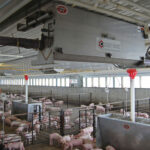Baling Tips for Quality Hay
Making high-quality bales that preserve hay quality boils down to a few guidelines. Here are just a few from last year’s issue of BALE. The 2014 issue of BALE will deliver to customers in early June. Bale quality begins in...
Baling Tips for Quality Hay
Making high-quality bales that preserve hay quality boils down to a few guidelines. Here are just a few from last year’s issue of BALE. The 2014 issue of BALE will deliver to customers in early June. Bale quality begins in...
Custom baler Reuben Wood turns out around 20,000 large square bales and up to 50,000 small square bales annually.
Making high-quality bales that preserve hay quality boils down to a few guidelines. Here are just a few from last year’s issue of BALE. The 2014 issue of BALE will deliver to customers in early June.
Bale quality begins in the windrow. If possible, make the windrow as wide or slightly wider than the baler pickup. This allows the crop to feed evenly across the full width of the bale. If it’s not possible, make it less than half the pickup width so the operator can weave from one side to the other. Otherwise, the pickup will result in a bale that is barrel-shaped.
Avoid baling when hay moisture is too low or too high to reduce leaf shatter and nutrient losses. In arid Arizona where Massey Ferguson customer Reuben Wood operates, chasing moisture means little sleep and good headlights. “Usually, it hits 15% between 3 and 5 a.m.”
Lawrence Drost, who uses two MF2170 models to annually bale about 42,000 bales near Hartley, Texas, says he remotely checks a humidity meter at each pivot location. Then, when the air humidity gets to around 50 to 55%, he physically checks the hay moisture.
Drost says he generally starts baling at about 13% at night when the dew comes on, and quits in the morning at about 11 or 12% as the dew goes off. “Sometimes we’ll add a little preservative with the HayBoss™ system, just to extend the window,” he says.
Keep up to date on regular maintenance. Ray Lynn Campbell, a Massey Ferguson customer and custom baler from Maypearl, Texas, either trades balers every year or completely rebuilds his machine in the off-season to ensure peak performance. While some of the maintenance is done by Livingston Machinery Co., his Hesston® by Massey Ferguson dealer in Chickasha, Okla., Campbell does much of the work himself, using only genuine AGCO parts.
“I’ve never used anything but replacement parts from the dealership,” says Campbell. “So I don’t have any experience with anything else.”
For more tips, see http://www.myfarmlife.com/features/baling-tips-for-quality-hay/.



